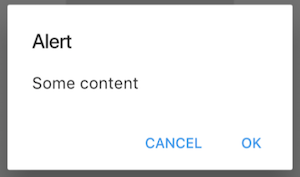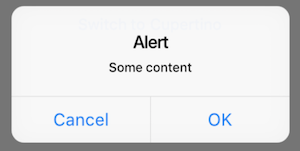This project is an attempt to see if it is possible to create widgets that are platform aware. Currently in order to render targeted Android or iOS device specific styles, you need to either conditionaly check the platform or create a set of widgets to render differently depending on the running platform.
This package only supports the Stable release. Beta, Dev or Master channels are not supported. This is due to pub.dev applying checks to packages that conform to the Stable version of the framework
The flutter ThemeData object used with the Theme widget has a platform property. This defaults to TargetPlatform.android on Android and TargetPlatform.ios on iOS, but when creating a ThemeData object, it can be set programmatically. Calling Theme.of(context).platform will return the current platform. Several Flutter library widgets use this field to change how they are rendered, and all of the Flutter Platform Widgets library widgets use this field to render the platform specific versions of things.
These set of widgets allow for rendering based on the target platform using a single cross platform set of widget.
Each PlatformWidget provides common properties directly as constructor arguments. If required further customization can be achieved by using the platform widget builder. See the Enhance section of each widget.
- PlatformWidget
- PlatformText
- PlatformSwitch
- PlatformSlider
- PlatformTextField
- PlatformButton
- PlatformIconButton
- PlatformApp
- PlatformScaffold
- PlatformAppBar
- PlatformNavBar
- PlatformAlertDialog
- PlatformDialogAction
- PlatformCircularProgressIndicator
- PlatformPageRoute
- ShowPlatformModalSheet
- PlatformProvider
A widget that will render either the android widget or cupertino widget based on the target platform. The widgets themselves do not need to be specifically Material or Cupertino.
return PlatformWidget(
ios: (_) => Icon(CupertinoIcons.flag),
android: (_) => Icon(Icons.flag),
);A widget that will render uppercase for Android. iOS will remain unchanged.
return PlatformText('Cancel');A switch widget that will use a Switch for android or a CupertinoSwitch for iOS.
return PlatformSwitch(
onChanged: (bool value) {},
value: value,
);return PlatformSwitch(
onChanged: (bool value) {},
value: value,
android: (_) => MaterialSwitchData(...),
ios: (_) => CupertinoSwitchData(...)
);A slider widget that will use a Slider for android or a CupertinoSlider for iOS
return PlatformSlider(
onChanged: (bool value) {},
value: value,
);return PlatformSlider(
onChanged: (bool value) {},
value: value,
android: (_) => MaterialSliderData(...),
ios: (_) => CupertinoSliderData(...)
);A text field widget that will use a TextField for android or a CupertinoTextField for iOS.
return PlatformTextField();return PlatformTextField(
android: (_) => MaterialTextFieldData(...),
ios: (_) => CupertinoTextFieldData(...)
);A button that will render a RaisedButton or FlatButton for android or a CupertinoButton for iOS.
return PlatformButton(
onPressed: () => print('send'),
child: PlatformText('Send'),
);Extend with WidgetBuilder for android or iOS.
return PlatformButton(
onPressed: () => print('send'),
child: PlatformText('Send'),
android: (_) => MaterialRaisedButtonData(...),
ios: (_) => CupertinoButtonData(...)
);Note: For android you can use the
FlatButtoninstead. To do this use theMaterialFlatButtonDataon theandroidFlatargument.
return PlatformButton(
onPressed: () => print('send'),
child: PlatformText('Send'),
androidFlat: (_) => MaterialFlatButtonData()
);A clickable (tappable) button with an icon. Uses IconButton for android or CupertinoButton for iOS.
return PlatformIconButton(
onPressed: () => print('info pressed'),
iosIcon: Icon(
CupertinoIcons.info,
size: 28.0,
),
androidIcon: Icon(Icons.info)
);Extend with WidgetBuilder for android or iOS.
Widget infoIconButton() {
return PlatformIconButton(
onPressed: () => print('info pressed'),
iosIcon: Icon(CupertinoIcons.info),
androidIcon: Icon(Icons.info),
android: (_) => MaterialIconButtonData(...),
ios: (_) => CupertinoIconButtonData(...),
);
}A top level widget for the applciation that uses MaterialApp for android or CupertinoApp for iOS.
return PlatformApp(
title: 'Flutter Demo',
home: ...
);Extend with WidgetBuilder for android or iOS.
return PlatformApp(
home: ...
android: (_) => MaterialAppData(...)
ios: (_) => CupertinoAppData(...)
);A Scaffold that provides the correctly hosted header (AppBar) and navigation bar (Bottom Bar) for each platform. Uses Scaffold for android or CupertinoTabScaffold for iOS with bottom tabs or CupertinoPageScaffold for iOS without bottom tabs.
return PlatformScaffold(
appBar: PlatformAppBar()
body: _buildContent(),
bottomNavBar: PlatformNavBar(),
iosContentPadding: false,
iosContentBottomPadding: false
);Note that the use of
iosContentPadding = trueis only required if the content is being obstruced behind the appBar.iosContentBottomPaddingis used if the content needs to be above the navBar and not go behind it
Extend with WidgetBuilder for android or iOS.
return PlatformScaffold(
appBar: PlatformAppBar()
body: _buildContent(),
bottomNavBar: PlatformNavBar(),
android: (_) => MaterialScaffoldData(...)
ios: (_) => CupertinoScaffoldData(...);
);Both the android and iOS builders are optional. If not provided the
Containerplaceholder widget will be returned.
The AppBar is the top Header bar with a title, leftside or rightside buttons. Uses AppBar for android or CupertinoNavigationBar for iOS.
return PlatformAppBar(
title: new Text('Platform Widgets'),
leading: PlatformIconButton()),
trailingActions: <Widget>[
PlatformIconButton(),
],
);In iOS if a solid color header is required and there is a ListView on the page, you would need to add some alpha to the color so that the ListView is not pushed down too far
appBar: PlatformAppBar(
title: Text('iOS Colored Header'),
ios: (_) => CupertinoNavigationBarData(
// Issue with cupertino where a bar with no transparency
// will push the list down. Adding some alpha value fixes it (in a hacky way)
backgroundColor: Colors.lightGreen.withAlpha(254),
),
),
Extend with WidgetBuilder for android or iOS.
return PlatformAppBar(
title: new Text('Platform Widgets'),
leading: PlatformIconButton()),
trailingActions: <Widget>[
PlatformIconButton(),
],
android: (_) => MaterialAppBarData(...),
ios: (_)=> CupertinoNavigationBarData(...),
);Note: hasNotch has been removed to allow for the widget to work with the change on the development branch of flutter. To work around the breaking change either use the Material
BottomAppBardirectly or cast the result from PlatformNavBar toBottomAppBarfor android builds and set thehasNotchproperty. Otherwise target version 0.2.0
The NavBar is placed at the bottom of the page with a set of buttons that typically navigate between screens. Implementing this widget requires the parent widget to manage the currentIndex of the page and to set PlatformNavBar.currrentIndex. Uses BottomAppBar with BottomNavigationBar for android or CupertinoTabBar for iOS.
return PlatformNavBar(
currentIndex: _selectedTabIndex,
itemChanged: (index) => setState(
() {
_selectedTabIndex = index;
},
),
items: [
BottomNavigationBarItem(),
BottomNavigationBarItem(),
],
);Extend with WidgetBuilder for android or iOS.
return PlatformNavBar(
currentIndex: _selectedTabIndex,
itemChanged: (index) => setState(
() {
_selectedTabIndex = index;
},
),
items: [
BottomNavigationBarItem(),
BottomNavigationBarItem(),
],
android: (_) => MaterialNavBarData(...),
ios: (_) => CupertinoTabBarData(...),
);The AlertDialog will render a caption/title, body/text and a set of action buttons specific for the platform. Uses AlertDialog for android or CupertinoAlertDialog for iOS.
Note use
showPlatformDialoginstead of eithershowDialogfrom the Material library orshowCupertinoDialogfrom the Cupertino library.
showPlatformDialog(
context: context,
builder: (_) => PlatformAlertDialog(
title: Text('Alert'),
content: Text('Some content'),
actions: <Widget>[
PlatformDialogAction(),
PlatformDialogAction(),
],
),
);Extend with WidgetBuilder for android or iOS.
showDialog(
context: context,
builder: (_) => PlatformAlertDialog(...),
ios: (_) => CupertinoAlertDialogData(...),
android: (_) => MaterialAlertDialogData(...),
)The DialogAction widget is used to describe the set of buttons on the AlertDialog. Uses FlatButton for android or CupertinoDialogAction for iOS.
PlatformDialogAction(
child: PlatformText('Cancel'),
onPressed: () => Navigator.pop(context),
),Extend with WidgetBuilder for android or iOS.
PlatformDialogAction(
child: PlatformText('Cancel'),
onPressed: () => Navigator.pop(context),
android: (_) => MaterialDialogActionData(...),
ios: (_) => CupertinoDialogActionData(...),
),A circular looking progress indicator. Uses CircularProgressIndicator for android or CupertinoActivityIndicator for iOS.
return PlatformCircularProgressIndicator();Extend with WidgetBuilder for android or iOS.
return PlatformCircularProgressIndicator(
android: (_) => MaterialProgressIndicatorData(...),
ios: (_)=> CupertinoProgressIndicatorData(...),
);This function can be used within the Navigator to push either the MaterialPageRoute for android or CupertinoPageRoute for iOS.
Navigator.push(
context,
platformPageRoute(
builder: pageToDisplayBuilder,
),
);This function is used to either display a ModalBottomSheet for android or CupertinoModalPopup for iOS.
showPlatformModalSheet(
context: context,
builder: (_) => PlatformWidget(
android: (_) => _androidPopupContent(),
ios: (_) => _cupertinoSheetContent(),
),
);Note: Since Android and iOS content may be quite different it may be useful tl use
PlatformWidget.
A Provider that provides access to the functions of swicthing platforms which can be accessed from any screen.
Requires to be placed at the root (above MaterialApp, CupertinoApp or PlatformApp).
return PlatformProvider(
builder: (BuildContext context) MaterialApp(...)
);An optional argument initialPlatform can be passed in to force the platform upon startup. This could be useful for development or if the platform is persisted externally (i.e. Shared preferences) and needs to be set on startup.
And to switch platforms...
PlatformProvider.of(context).changeToMaterialPlatform();
or
PlatformProvider.of(context).changeToCupertinoPlatform();
- UI / Unit Tests.
- Code documentation
When importing flutter_platform_widgets you can check isMaterial or isCupertino to determine what style will be used. This is independent to Platform.isAndroid or Platform.isIOS from 'import 'dart:io'
See the example code for how this is used.
Please create an issue to provide feedback or an issue.
Inspired by the example given by Swav Kulinski (https://github.com/swavkulinski/flutter-platform-specific-widgets)





